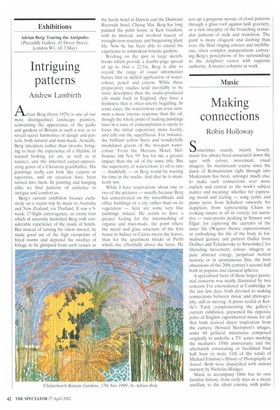Exhibitions
Adrian Berg: Touring the Antipodes (Piccadilly Gallery, 43 Dover Street, London Wl, till 3 May)
Intriguing patterns
Andrew Lambirth
Adrian Berg (born 1929) is one of our most distinguished landscape painters, reinventing the appearance of the parks and gardens of Britain in such a way as to reveal secret harmonies of design and pattern, both natural and man-made. Actually. Berg interprets rather than invents, bringing to bear the experience of a lifetime of trained looking (at art, as well as at nature), and the inherited carpet-appreciating genes of a Ukranian grandfather. His paintings really can look like carpets or tapestries, and on occasion have been turned into them. In painting and hanging alike we find patterns of existence to intrigue and comfort us.
Berg's current exhibition focuses exclusively on a recent trip he made to Australia and New Zealand, via Thailand. It was a 9week. 17-flight extravaganza, an exotic tour which of necessity furnished Berg with considerable experience of the inside of hotels. But instead of turning his vision inward, he made good use of the high viewpoints of hired rooms and depicted the swathes of foliage to be glimpsed from such venues as the Savile hotel in Darwin and the Diamond Riverside hotel, Chiang Mai. Berg has long painted the palm house at Kew Gardens, with its intricate and involved tracery of wrought-iron structure and burgeoning plant life. Now he has been able to extend his experience to antipodean botanic gardens.
Working on the spot in large sketchbooks which provide a double-page spread of up to 16in x 22.5in. Berg is able to record the range of visual information before him in skilled application of watercolour, pencil and crayon. While these preparatory studies tend inevitably to be more descriptive than the studio-produced oils made back in England, they have a freshness that is often utterly beguiling. In some cases, the watercolour can even summon a more intense response than the oil, though the whole point of making paintings later in a state of contemplation is surely to focus the initial experience more keenly, and edit out the superfluous. For instance, the brilliant yellow burst and wonderfully modulated greens of the two-part watercolour 'From the Mercure Hotel. Melbourne, 6th Nov 99' has for me a greater impact than the oil of the same title. But the superiority of watercolour to oil is rare thankfully — or Berg would be wasting his time in the studio. And that he is manifestly not.
While I have reservations about one or two of the pictures — usually because Berg has concentrated on the towerblocks and office buildings of a city rather than on its vegetation — here are some very fine paintings indeed. He seems to have a greater feeling for the intermeshing of organic and man-made, the point where the metal and glass structure of the fern house in Sidney or Cairns meets the leaves, than for the apartment blocks of Perth which rise effortfully above the trees. He sets up a gorgeous mosaic of cloud patterns through a glass roof against lush greenery, or a rich interplay of the branching tentacular patterns of stalk and stanchion. The paint is more eloquent and dashing than ever, the fluid ringing colours and mellifluous, often complex juxtapositions conveying Berg's perceptions of his surroundings to the delighted viewer with supreme authority. A master colourist at work.


































































 Previous page
Previous page